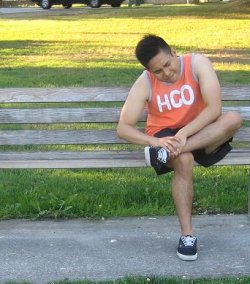Plantar fasciitis is characterized as pain in the bottom of the heel. The plantar fascia is a thin ligament that attaches the heel to the front of the foot. It also helps support the arch in the foot which helps with walking.
The plantar fascia has to endure wear and tear in daily life. These ligaments function as shock absorbers and support the arch of the foot. When putting plenty of pressure on the feet, it can cause damage or tearing of the ligaments. The plantar fascia becomes inflamed and causes pain in the heel and stiffness.
Causes
- Performing repetitive activities such as jobs that need prolonged walking or standing on hard and irregular surface as well as running.
- The abnormal inward twisting or rolling of the foot or pronation, flat feet, tight calf muscles, high arches and a tight tendon located at the back of heels or the Achilles tendon.
- Putting extra stress on the feet such as being overweight or wearing improperly cushion shoes and those that does not fit well and already worn out.

Plantar fasciitis is characterized as pain in the bottom of the heel. - Middle-aged individuals are susceptible to this condition
- An injury to the foot
Symptoms
- Pain that becomes severe when climbing stairs or standing on the toes.
- Stiffness and pain usually in the morning or after resting and gets better after a few steps and eventually becomes worse.
- There is pain after prolonged standing
- Pain when starting an exercise routine and minimized or subsides as the exercises continues and pain returns when the exercise is finished.
Treatment of plantar fasciitis
- Take plenty of rest when there is pain in order to help relieve the strain caused on the plantar fascia. When capable of resuming an exercise routine, avoid exercising excessively by lessening the distance travelled while walking or running. Switch to a low-impact activity such as cycling or swimming in order to help minimize strain on the plantar fascia.
- Apply an ice pack on the affected area for 20 minutes at least 3-4 times every day in order to help lessen the inflammation and pain. Another way is massaging the sole and heel using an ice cube several times every day.
- Wear over-the-counter arch support in order to lessen the tension on the plantar fascia, Achilles tendon and calf muscles by spreading the weight during movement.
- Perform stretching exercises in order to help minimize tension on the arch of the foot. Make sure to warm up first and then perform stretching at least 2-3 sets of exercises every day at 6-7 days every week.
- Take the prescribed over-the-counter pain medications such as ibuprofen or acetaminophen to lessen the pain and inflammation of plantar fasciitis.
- Wear shoes that have low to moderate heel with good arch and heel support. Avoid flip-flops, worn-out running shoes and ballet flat shoes.
- Wear a night splint since it helps in stretching the plantar fascia while sleeping and promote fast healing of the tissue.
FACT CHECK
https://en.wikipedia.org/wiki/Plantar_fasciitis
https://orthoinfo.aaos.org/en/diseases–conditions/plantar-fasciitis-and-bone-spurs
https://www.mayoclinic.org/diseases-conditions/plantar-fasciitis/symptoms-causes/syc-20354846
